<< Previous | Displaying results 6701-6725 of 6769 for "" | Next >>
View of Zbaszyn, the site of a refugee camp for Jews of Polish nationality who were expelled from Germany. The Jewish refugees, hungry and cold, were stranded on the border, denied admission into Poland after their expulsion from Germany. Photograph taken between October 28, 1938, and August 1939. Warsaw-based historian, political activist, and social welfare worker Emanuel Ringelblum spent five weeks in Zbaszyn, organizing assistance for the refugees trapped on the border.
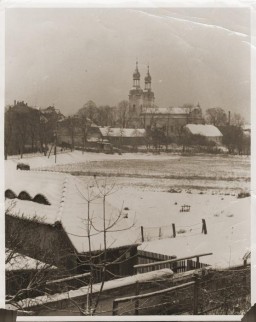
View of the flour mill in Zbaszyn, which served as a refugee camp for Jews expelled from Germany. The Jewish refugees, hungry and cold, were stranded on the border, denied admission into Poland after their explusion from Germany. Photograph taken between October 28, 1938, and August 1939. Warsaw-based historian, political activist, and social welfare worker Emanuel Ringelblum spent five weeks in Zbaszyn, organizing assistance for the refugees trapped on the border.
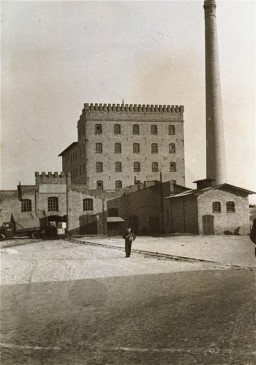
November 1938 group portrait of Jews of Polish nationality who were expelled from Nuremberg, Germany, to the Polish border town of Zbaszyn. The Jewish refugees were stranded on the border and were denied admission into Poland after their explusion from Germany.Pictured from left to right are: Leo Fallmann; Rosa Fallmann; Mr. Auerbach; Mr. Zahn; unknown; unknown; Chaim Kupfermann; Anni Kupfermann; Simon Wassermann; unknown; Regina Holzer; and Bertha Holzer.
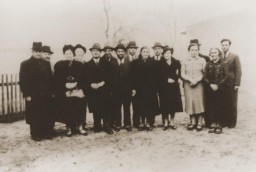
Theo Markus Verderber's mother, Gelle, was among the Jews of Polish nationality expelled from Germany in October 1938. Theo and his younger brother were born in Germany, but went with their mother to a refugee camp in the border town of Zbaszyn. Hungry and cold, the refugees were stranded on the border, unwelcome in either Germany or Poland. Theo was ultimately chosen to join a Kindertransport to England, arriving there in February 1939. His mother, sister and youngest brother remained in…
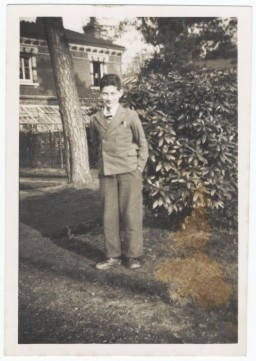
Jews from Subcarpathian Rus get off the deportation train and assemble on the ramp at the Auschwitz-Birkenau killing center in occupied Poland. May 1944.
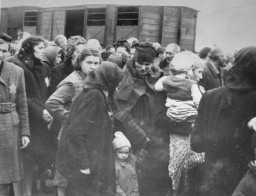
Soviet Foreign Minister Molotov signs the German-Soviet Pact. Joachim von Ribbentrop and Josef Stalin stand behind him, Moscow, Soviet Union, August 23. 1939.
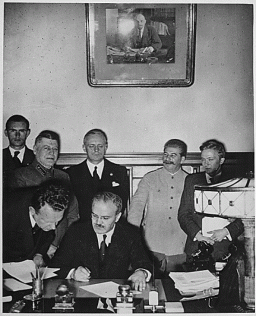
A 1915 portrait of Willem Arondeus. During World War II, Arondeus, a gay member of the Dutch resistance, participated in an attack on the Amsterdam Population Registry offices. His group set fire to several thousand files in an attempt to destroy government records of Jews and others sought by the Nazis. Soon after the attack, his unit was betrayed. The Nazis arrested and executed Arondeus in 1943. Blaricum, the Netherlands, 1915.
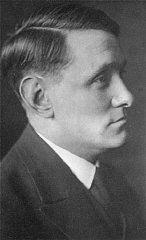
A large family group celebrates the Passover seder. Lodz, Poland, ca. 1938-1939.
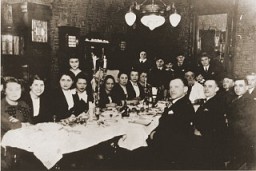
African American soldiers pose next to an oven in the crematorium of the Ebensee concentration camp.
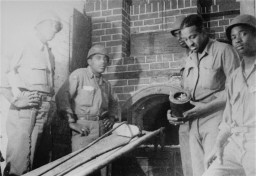
HIAS immigration certificate issued to Manius Notowicz in Munich, Germany. The document states that Notowicz will travel on the Marine Flasher on February 22, 1947, to New York City.
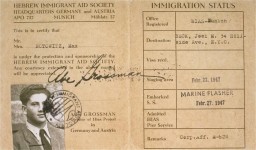
Members of the orchestra at the Janowska concentration camp perform while standing in a circle around the conductor in the Appelplatz [roll call area]. Pictured at the right, in the light uniform, is camp commandant Warzok Franz. The Janowska orchestra included some of the leading Jewish musicians in Lvov, among them violinist Leonid Stricks and cellist Leon Eber. The SS forced the orchestra to perform during selections and actions and even "commissioned" a special composition to be played on these…
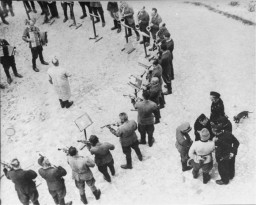
Pastor Martin Niemöller speaks to reporters after his release from a concentration camp. Germany, 1945.
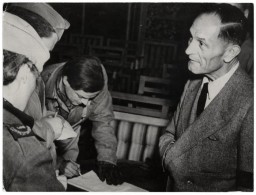
The Kloster Indersdorft displaced persons camp opened in July 1945. By mid-September, 1945, 192 boys and girls from thirteen nations, including 49 Jewish children, were sheltered at Kloster Indersdorf, more than double what had been anticipated. Over the next year, the numbers increased to over 300. Five hours each day were allocated to education. Teachers were drawn from the staff as well as the local community. Many of the children had few or no literacy skills; they also benefitted from art, music,…
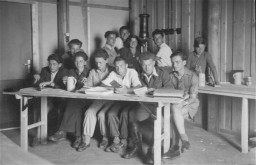
Identification card issued to Oskar Russ in the Feldafing displaced persons' camp. Oskar Russ was born in Poland in 1907. During the Holocaust, he was imprisoned in the Dachau concentration camp. After liberation, he was in the Feldafing displaced persons camp before immigrating in 1947 to the United States with his wife (whom he had married in Feldafing).
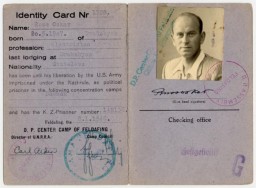
Portrait of Rabbi Shimon Hoberband, who was involved in the activities of Emanuel Ringelblum's Oneg Shabbat archives in the Warsaw ghetto.
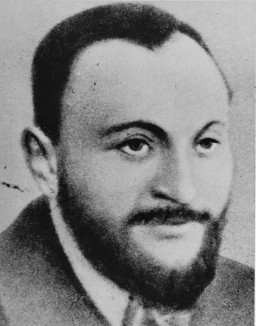
Spectators cheer passing SA formations during a Reichsparteitag (Reich Party Day) parade in Nuremberg.
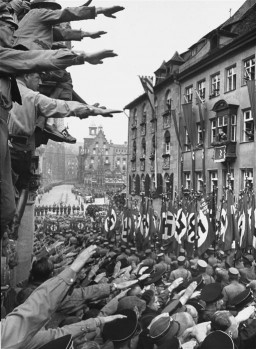
A technician determines the racial makeup of a young woman by the color of her hair.
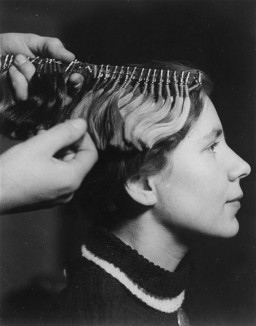
Visitors view the "Degenerate Art" exhibition (Entartete Kunst) at the Munich Hofgarten in July 1937. Works by Lovis Corinth and Franz Marc are visible, among others.

Propaganda slide which contrasts a person of mixed race (left) with a healthy "Aryan" youth (right).
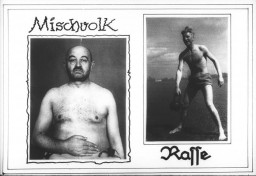
Prisoners march in the courtyard of the Gestapo headquarters in Nuremberg. The original caption to the photograph reads: "The courtyard of the Gestapo headquarters, Nurnberg. These appear to be Frenchmen taken to Germany as slave laborers".
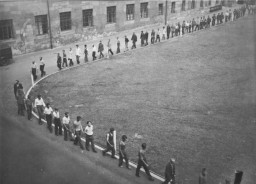
Group portrait of women and children standing outside in Warsaw before the war. Warsaw, Poland, ca. 1938.
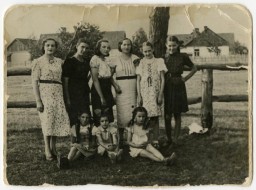
The study of the Holocaust raises questions about how the world can recognize and respond to indications that a country is at risk for genocide or mass atrocity. While each genocide is unique, in most places where genocide occurs, there are common...
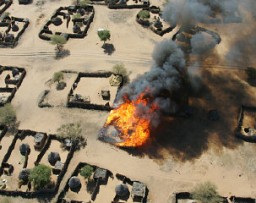
Many Europeans witnessed acts of persecution, including violence against Jews and, later, deportations. While few were aware of the full extent of the Nazi "Final Solution," this history poses difficult and fundamental questions about human behavi...
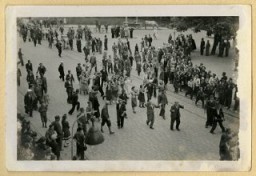
How involved in the Holocaust were German professionals and civil leaders? What were some of the motivations and pressures that led to a wide range of behavior? What indeed was the range of behavior, from complying to perpetrating? Explore...
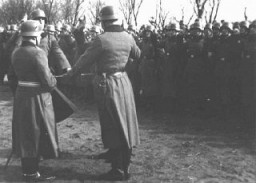
The leaders of Nazi Germany, a modern, educated society, aimed to destroy millions of men, women, and children because of their Jewish identity. Understanding this process may help us to better understand the condit...

We would like to thank Crown Family Philanthropies, Abe and Ida Cooper Foundation, the Claims Conference, EVZ, and BMF for supporting the ongoing work to create content and resources for the Holocaust Encyclopedia. View the list of donor acknowledgement.